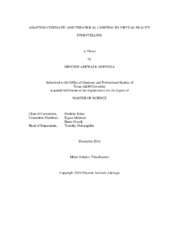| dc.description.abstract | When immersed in a 3-dimensional virtual world story, viewers may become distracted because the virtual world affords them freedom to navigate and look around. This also means that the story plot is open to different interpretations. This raises the question of how to best guide viewer experience in virtual world story scenarios. To address this issue, our methodology has been to study the use of lighting in cinema and theater to direct attention and explore how these techniques can be adapted to virtual world scenarios. Some of the techniques studied and analyzed include the use of light contrast, colored lights, moving lights, staged lighting, fading lights, pulsing lights and follow spotlights. Since lighting serves a similar purpose in both theater and cinema, we discuss and propose with examples how these lighting techniques may be used to direct attention in virtual reality storytelling.
The focus in this thesis is on translating principles of cinematic and theatrical lighting into virtual world narratives. From this exploration, we developed applicable approaches and created illustrative examples. A detailed discussion is documented on the process, production and implementation of cinematic and theatrical lighting approaches into VR. From this we gained insights into the effective use of lighting to guide viewer attention. For each lighting technique, the most important function is its ability to selectively direct viewer attention while supporting the narrative. A set of guidelines on how to effectively direct viewer attention using lighting in virtual world scenarios is presented. The purpose of these guidelines is to aid storytellers in creating lighting to direct viewer attention in virtual world story scenarios. This is achieved by providing information on what to consider when evaluating the story needs, developing the lighting design and its implementation. | en |


